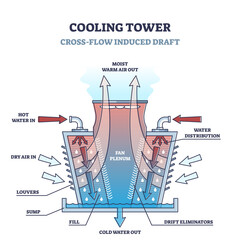Cooling towers are essential components in industries and large buildings that rely on efficient temperature regulation. They are designed to remove excess heat generated by processes, machinery, or HVAC systems, ensuring smooth operations and improved energy efficiency. By understanding how a cooling tower works, the different types available, and proper maintenance practices, one can appreciate its critical role in modern infrastructure.

What is a Cooling Tower
A cooling tower is a heat rejection device that transfers waste heat into the atmosphere. It works by allowing water to come into contact with air, causing part of the water to evaporate, which in turn removes heat from the system. This cooled water is then recirculated back into the system to absorb more heat, creating an efficient cycle of temperature control.
Cooling towers are commonly used in power generation plants, manufacturing facilities, chemical plants, refineries, and commercial buildings. They help regulate temperatures in machinery, reduce energy costs, and extend the life of industrial equipment.
How Cooling Towers Work
The working principle of a cooling tower involves three main steps:
- Hot Water Enters the Tower – Warm water from industrial processes or HVAC systems is pumped into the cooling tower.
- Heat Exchange Process – The water is distributed over a large surface area inside the tower, where it comes into contact with air. As the water trickles down, fans or natural draft systems force air upward, promoting evaporation.
- Cooled Water Returns – The cooled water is collected at the bottom of the tower and recirculated back into the system, while the evaporated water is released as vapor into the atmosphere.
This continuous process keeps systems operating at safe and efficient temperatures.
Types of Cooling Towers
Cooling towers are classified into different types based on their design and air circulation method:
- Natural Draft Cooling Towers – These rely on natural airflow to move air through the system. They are typically tall, with a hyperbolic shape, and are often used in power plants.
- Mechanical Draft Cooling Towers – These use fans to control the flow of air. They can be further divided into:
- Induced Draft Towers – Fans pull air upward through the tower.
- Forced Draft Towers – Fans push air into the system at the base of the tower.
- Crossflow Cooling Towers – Air moves horizontally across falling water.
- Counterflow Cooling Towers – Air moves upward while water flows downward, creating efficient heat transfer.
Each type of cooling tower has unique advantages depending on the scale, climate, and specific application.
Benefits of Using Cooling Towers
Cooling towers provide several key advantages that make them an indispensable part of industrial and commercial systems:
- Energy Efficiency – By reducing the temperature of circulating water, cooling towers lower energy consumption in machinery and HVAC systems.
- Cost Savings – Efficient cooling reduces the need for frequent repairs and extends the lifespan of equipment.
- Environmental Benefits – By recycling water in a closed-loop system, cooling towers reduce overall water waste.
- Improved Safety – Proper cooling prevents overheating, reducing the risk of equipment failure or workplace hazards.
- Adaptability – Cooling towers can be customized for different industries, from power generation to food processing.
Common Problems in Cooling Towers
Like any mechanical system, cooling towers may experience issues that require timely attention:
- Scaling and Mineral Deposits – Minerals from water can accumulate, reducing efficiency and clogging the system.
- Corrosion – Exposure to water and air can corrode metal components if not properly treated.
- Biological Growth – Warm, moist conditions can encourage algae and bacteria, which may affect water quality and system performance.
- Mechanical Failures – Problems with fans, motors, or pumps can disrupt airflow and cooling efficiency.
- Leaks and Water Loss – Improper sealing or wear and tear can lead to water waste.
Recognizing these issues early helps ensure uninterrupted operations.
Cooling Tower Maintenance
Maintaining a cooling tower is vital for efficiency, safety, and longevity. Best practices include:
- Regular Cleaning – Remove debris, scale, and biological growth to maintain water quality and efficiency.
- Water Treatment – Use proper chemical treatments to prevent scaling, corrosion, and bacterial growth.
- Mechanical Inspections – Regularly check fans, motors, pumps, and nozzles to ensure smooth operation.
- Leak Prevention – Inspect for cracks, wear, or faulty seals that may cause water loss.
- Seasonal Shutdowns – If the tower is not used year-round, perform thorough cleaning and inspections before restarting.
Preventive maintenance reduces downtime and extends the life of cooling towers.
Modern Innovations in Cooling Towers
Advancements in technology have led to more efficient and sustainable cooling tower designs. Some of the latest improvements include:
- High-Efficiency Fill Materials – These enhance heat transfer and reduce energy consumption.
- Variable Speed Fans – Adjust fan speed based on demand, lowering operational costs.
- Water-Saving Designs – Modern systems minimize evaporation loss and water usage.
- Automation and Monitoring – Smart systems provide real-time monitoring, making it easier to detect issues and optimize performance.
These innovations make cooling towers more eco-friendly and cost-effective for businesses.
Importance of Professional Expertise
While basic maintenance can be performed in-house, certain repairs and water treatment procedures require professional expertise. Skilled technicians can provide comprehensive inspections, identify hidden issues, and recommend the most effective solutions. Relying on experts ensures safety, efficiency, and compliance with environmental standards.
Cooling towers are crucial for temperature regulation in industrial processes and commercial buildings. They enhance efficiency, reduce energy costs, and protect valuable equipment from overheating. By understanding how cooling towers work, recognizing common issues, and following proper maintenance practices, businesses can maximize performance and extend system lifespan.
With modern innovations and careful upkeep, cooling towers will continue to play a vital role in energy management and sustainable operations for years to come.